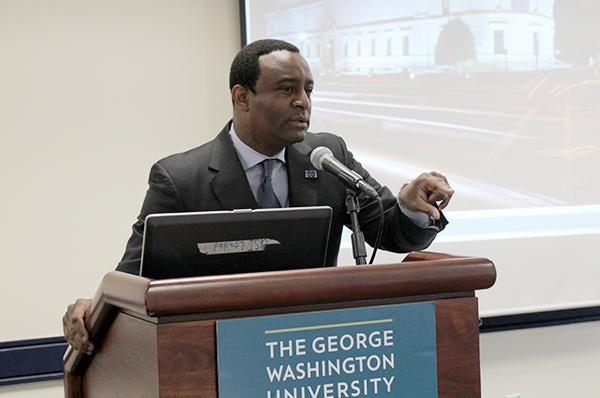GW has launched a nationwide search for a director who will lead the Corcoran through the next steps of its transition into the University’s largest college.
Dean Ben Vinson said last week that the search committee will look for a leader who will collaborate with other academic departments in the liberal arts school and across the University.
“What are we looking for? An experienced leader and practitioner of the arts. A consensus builder. Someone with a passion for interdisciplinary and for developing new lines of inquiry that may transcend the arts,” Vinson said at the Faculty Senate meeting Friday.
The director will oversee how the school moves many of GW’s own arts programs under the Corcoran’s name. GW and Corcoran faculty have already started comparing their courses to see how programs could merge.
Departments interested in working with the arts school will help push forward the interdisciplinary learning that the University has stressed under the strategic plan.
Vinson pointed to partnerships that Corcoran faculty members and GW’s physics, anthropology and chemistry departments have already forged this year as examples of how the Corcoran is advancing interdisciplinary work within the college.
“Having a robust school of the arts and design embedded in the college provides an additional opportunity for our students to be able to utilize the arts curriculum that we’re working on to help them in other realms in other areas,” Vinson said.
The acquisition of the Corcoran also allows GW to open new partnerships with D.C. institutions, like the Smithsonian, National Gallery of Art and the Phillips Collection, Vinson said. While the Corcoran might be the starting point for those relationships, Vinson said other academic areas could benefit as well.
“Where these partnerships may differ from previous Corcoran relationships is in the wider array of disciplines that we can bring to the table and broader sweep of students and faculty,” he said.
The school will maintain its focus on the arts by requiring students to submit a portfolio of their work in their applications. But having an arts school will allow other academic areas to access new facilities, such as a paleoanthropology lab that studies skulls.
Vinson said students applying to the college will be evaluated based on GW’s “standards of academic excellence,” although they will not have to submit SAT scores.
Officials also announced over the summer that new Corcoran students will have to complete the G-PAC requirements of the Columbian College.
The director search committee, led by professor of music Douglas Boyce, is now in the process of choosing a search firm, Vinson said. Administrators are also looking to bring consultants from education firms to campus, which could help prepare the school for its accreditation review next fall.
The Columbian College added 21 full-time arts professors this year from the Corcoran acquisition and 304 new students.
Lynn Sures, the head of the Corcoran’s fine arts program, said introducing Corcoran traditions to GW has been difficult as new challenges have come up. But the Corcoran’s current leadership and faculty have been working with GW officials to make sure those traditions, like senior exhibitions that take a year to put together, don’t disappear.
“It wasn’t clear to our GW administration what would be entailed in putting together such a comprehensive thesis exhibition,” Sures said. “We had to explain that we needed a college exhibitions director, and I’m really happy to say that we’re in the absolute final stages of getting hired a college exhibitions director.”
That comes as GW has cut back on hiring in the Columbian College. The school has posted just five new faculty searches on its jobs website this year, whereas faculty say the college typically posted up to 20 new positions annually.
Andy Grundberg, a professor of art and design, said Corcoran faculty have met weekly to discuss different challenges and ways to improve communication with GW. He said interim Corcoran director Alan Wade has been a strong presence in the transition.
Wade, a professor of theater and dance, declined to comment on the transition or how it has affected GW’s arts departments.
The changes could ease as GW begins to allocate more resources toward the Corcoran in this year’s budgeting process, Grundberg said. He added that merging departments could take over a year.
“I think what’s happened since the semester started is everyone shifted from, ‘Let’s hang on to try and fight for the way things always were,’ to a focus on, ‘Gee, there’s a whole lot that GW has to offer that we haven’t had before,’” he said.







